Owls aren’t the only animals with sight superpowers. Eyes are important survival tools. They help animals hunt prey or avoid predators in all kinds of environments.
Dragonflies have two giant eyes that cover almost their entire heads. That way, these insects can see ahead, behind, and sideways—and keep their eyes peeled for fish and birds that might attack them.
Chameleons can point each eye in a different direction. One can scan the shadowy forest for dangerous snakes while the other searches for tasty bugs to eat. Then there’s the red-eyed tree frog. It flashes its fiery-red eyes to scare hungry birds and escape!
Your eyes are important too. They keep you safe by showing you that baseball speeding your way. (Quick, duck!) And they keep you healthy by washing away dirt with tears.
So make sure you protect your incredible eyes by wearing sunglasses when it’s bright out and goggles while doing science experiments. Though you can’t see in the dark like an owl, your eyes are pretty extraordinary!

